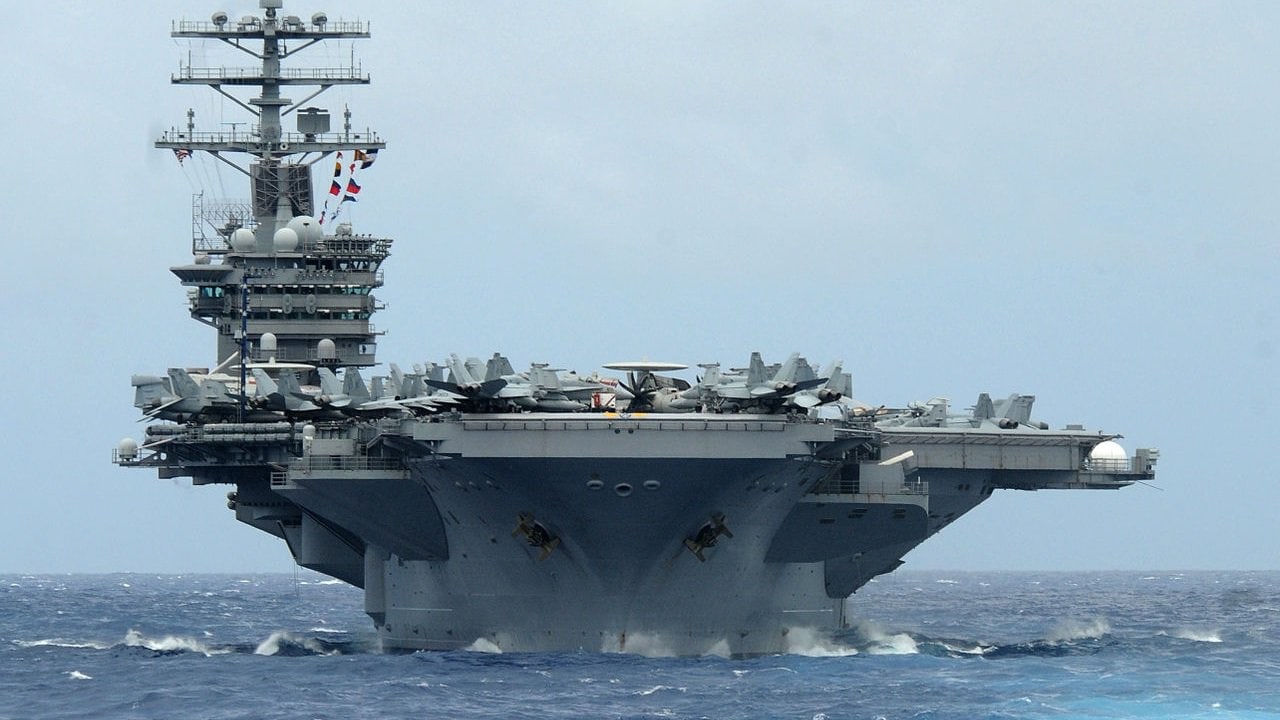Meet the Nimitz-Class: Commissioned in 1975, the USS Nimitz was the second nuclear-powered aircraft carrier ever built after the USS Enterprise (CVN-65).
For decades, the 10 Nimitz class carriers represented the largest and most capable warships in the world, each designed for roughly half-century service lives with one mid-life refueling.
Since the 50-year benchmark is rapidly approaching, the U.S. Navy plans to replace these tried and tested vessels with USS Gerald R. Ford (CVN-78) in the upcoming years. Aircraft carriers are arguably the most important component of America’s Naval forces, which is why the first question often asked in times of crisis is: “Where are the carriers?”
Introducing the Nimitz-Class
The Nimitz-class aircraft carriers were initially designed to supplement the older Kitty Hawk, Forrestal and Enterprise classes.
Several improvements differentiate the Nimitz-class from its predecessors, including fuel output and reactor quantity.
Nimitz-class carriers carry two reactors, which take up less space than the eight reactors needed on Enterprise-class ships.
Two Westinghouse A4W nuclear reactors power the Nimitz, which allows the ship to reach speeds in excess of thirty knots. Additionally, Nimitz-class carriers can carry 90% more aviation fuel and 50% more ordnance than the Forrestal-class ships.
The Nimitz measures at just over 1,000 feet long, making it one of the largest ships in any navy across the globe. The massive vessel displaces around 97,000 tons and is run by around 5,000 sailors and Marines including the air wing.
USS Nimitz (CVN-68) is the lead ship of the carrier class, named to honor Admiral Chester Nimitz who led the U.S. Navy through World War II.
Ten Nimitz-class carriers were constructed over the years, with the last of the class- USS George H.W. Bush (CVN-77) commissioned in 2009.
Up until the new USS Gerald R. Ford carrier, the Nimitz-class were the largest warships of its kind to sail the seas anywhere on the planet.
The Nimitz-class and Power Projection
Each of the ten Nimitz-class carriers can carry around 60 airframes, including a variety of fixed-wing and rotary-wing aircraft with up to 90 different types.
Under normal conditions, airframes usually launch from runways with plenty of room to build up the speed required for flight.
While the 1,092-foot-long deck of the Nimitz-class carriers seems large for a deck, it is not nearly the length needed for a fully loaded F/A-18 fighter weighing over 60,000 pounds to launch from.
The addition of a steam catapult allows the carrier to circumvent the need for a longer runway.
As explained by Popular Mechanics, “Steam is diverted from the ship’s boilers—steam boilers powered by the ship’s nuclear reactors—and piped up to just under the flight deck, where it is held and pressurized in special tanks. In the meantime, the front landing gear of a carrier aircraft is loaded onto a small, plate-sized shuttle. When the aircraft is ready for launch, the steam is suddenly released and, in a burst of power, accelerates the shuttle—and attached aircraft—down the flight deck to takeoff speeds.”
In addition to airframes, the newer Nimitz-class carriers feature three Raytheon GMLS mk29 eight-cell launchers for NATO Sea Sparrow surface-to-air missiles, among other close-in weapons systems.
Regardless of age, the Nimitz-class of carriers are formidable vessels that continue to haunt foreign Navies.
Expertise and Biography of the Author
Maya Carlin is a Senior Editor with 19FortyFive. She is also an analyst with the Center for Security Policy and a former Anna Sobol Levy Fellow at IDC Herzliya in Israel. She has by-lines in many publications, including The National Interest, Jerusalem Post, and Times of Israel.
From 19FortyFive
Footage Shows World War I Guns Being Used in Ukraine
‘Vacuum Bombs Destroyed’: Ukraine Footage Shows Putin’s Thermobaric Rockets Destroyed
BOOM! Ukraine Video Shows Precision Strike on Russian Air-Defense System

